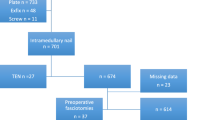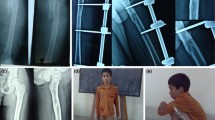Abstract
Purpose
Pediatric tibial shaft fractures are common injuries encountered by the orthopaedic surgeon. Flexible intramedullary nailing has become popular for pediatric patients with tibial shaft fractures that require operative fixation. The purpose of our study was to evaluate the incidence of, and the risk factors for, compartment syndrome (CS) after flexible intramedullary nailing of these injuries.
Methods
A retrospective review of tibial shaft fractures treated consecutively with flexible intramedullary nailing at our institution from 2003 to 2010 was performed. The incidence of CS after flexible nailing was recorded. In addition, age, weight, mechanism of injury, polytrauma, presence of an open fracture, presenting neurovascular exam, fracture pattern, delay in treatment (>24 h from injury), prior closed reduction attempts, method of reduction (open vs. closed) in the operating room, total fluoroscopy time, and operative time were recorded. Comparisons were made between children who developed CS and those who did not.
Results
Thirty-one children met inclusion criteria with a mean age of 11.2 years (range, 6.3–15.3 years); all were boys. Nearly, 20% of children developed CS after flexible nailing of their fractures. Those who developed CS after flexible nailing were heavier than the unaffected group (52.6 ± 14.5 kg vs. 39.4 ± 15.2 kg, P = 0.05); with a greater percentage of children 50 kg or greater (83.3% vs. 26.1%, P = 0.02) within the CS group. Children who developed CS were also more likely to present with neurologic deficits in the absence of compartmental swelling prior to surgery (66.7% vs. 9.1%, P = 0.009), and more likely to have comminuted/complex fracture patterns (83.3% vs. 29.1%, P = 0.02). There was no difference between patients who did and did not develop CS in regards to age (P = 0.42), high-energy injury mechanism (P = 0.30), polytrauma (P = 1.0), delay in treatment (P = 0.28), prior closed reduction attempts (P = 1.0), method of reduction (open vs. closed; P = 1.0) in the operating room, total fluoroscopy time (P = 0.96), and total operative time (P = 0.45). In addition, there was no difference (P = 0.65) in the rates of CS between children with open and closed fractures.
Conclusions
There is a high risk of CS after flexible intramedullary nailing of pediatric tibial shaft fractures regardless of whether an injury is open or closed. Variables that would seemingly be associated with the development of CS (high-energy injury mechanisms, polytrauma, treatment delay, prior closed reduction attempts, and closed reduction in the operating room) were not statistically associated with CS in our study. Clinicians should be wary for the development of CS whenever utilizing flexible nails for tibial shaft fractures, especially when the following co-morbidities are present: the child weighs greater than 50 kg, has complex/comminuted fracture patterns, or has a neurologic deficit in the absence of compartmental swelling prior to operative intervention.






Similar content being viewed by others
References
Setter KJ, Palomino KE (2006) Pediatric tibia fractures: current concepts. Curr Opin Pediatr 18:30–35
Galano GJ, Vitale MA, Kessler MW et al (2005) The most frequent traumatic orthopedic injuries from a national pediatric inpatient population. J Pediatr Orthop 25:39–44
Shannak AO (1988) Tibial fractures in children: follow-up study. J Pediatr Orthop 8:306–310
Mashru JP, Herman MJ, Pizzutillo PD (2005) Tibial shaft fractures in children and adolescents. J Am Acad Orthop Surg 13:345–352
Myers SH, Spiegel D, Flynn JM (2007) External fixation of high-energy tibia fractures. J Pediatr Orthop 27:537–539
Kubiak EN, Egol KA, Scher D et al (2005) Operative treatment of tibial fractures in children: are elastic stable intramedullary nails an improvement over external fixation? J Bone Joint Surg Am 87:1761–1768
Wessel L, Seyfriedt CS, Hock S, Waag KL (1997) Pediatric tibial fractures: is conservative therapy still currently appropriate? Unfallchirurg 100:8–12
Sankar WN, Jones KJ, David Horn B et al (2007) Titanium elastic nails for pediatric tibial shaft fractures. J Child Orthop 1:281–286
Vallamshetla VR, De Silva U, Bache CE et al (2006) Flexible intramedullary nails for unstable fractures of the tibia in children. An eight-year experience. J Bone Joint Surg Br 88:536–540
Gordon JE, Gregush RV, Schoenecker PL et al (2007) Complications after titanium elastic nailing of pediatric tibial fractures. J Pediatr Orthop 27:442–446
Srivastava AK, Mehlman CT, Wall EJ et al (2008) Elastic stable intramedullary nailing of tibial shaft fractures in children. J Pediatr Orthop 28:152–158
Lascombes P, Haumont T, Journeau P (2006) Use and abuse of flexible intramedullary nailing in children and adolescents. J Pediatr Orthop 26:827–834
O’Brien T, Weisman DS, Ronchetti P et al (2004) Flexible titanium nailing for the treatment of the unstable pediatric tibial fracture. J Pediatr Orthop 24:601–609
Ligier JN, Metaizeau JP, Prévot J et al (1988) Elastic stable intramedullary nailing of femoral shaft fractures in children. J Bone Joint Surg Br 70:74–77
Moroz LA, Launay F, Kocher MS et al (2006) Elastic nailing of fractures of the femur in children. predictors of complications and poor outcome. J Bone Joint Surg Br 88:1361–1366
Sink EL, Gralla J, Repine M (2005) Complications of pediatric femur fractures treated with titanium elastic nails: a comparison of fracture types. J Pediatr Orthop 25:577–580
McQueen MM, Christie J, Court-Brown CM (1996) Acute compartment syndrome in tibial diaphyseal fractures. J Bone Joint Surg [Br] 78:95–98
Grottkau BE, Epps HR, Di Scala C (2005) Compartment syndrome in children and adolescents. J Pediatr Surg 40:678–682
Gál P, Melichar I (1999) The compartment syndrome in injuries of the lower extremity in children. Rozhl Chir 78:55–58
Court-Brown CM, Byrnes T, McLaughlin G (2003) Intramedullary nailing of tibial diaphyseal fractures in adolescents with open physes. Injury 34:781–785
Goodwin RC, Gaynor T, Mahar A et al (2005) Intramedullary flexible nail fixation of unstable pediatric tibial diaphyseal fractures. J Pediatr Orthop 25:570–576
Salem KH, Lindemann I, Keppler P (2006) Flexible intramedullary nailing in pediatric lower limb fractures. J Pediatr Orthop 26:505–509
Yuan PS, Pring ME, Gaynor TP et al (2004) Compartment syndrome following intramedullary fixation of pediatric forearm fractures. J Pediatr Orthop 24:370–375
Mubarak SJ, Owen CA, Hargens AR et al (1978) Acute compartment syndromes: diagnosis and treatment with the aid of the wick catheter. J Bone Joint Surg Am 60:1091–1095
Heppenstall RB, Sapega AA, Scott R et al (1988) The compartment syndrome. An experimental and clinical study of muscular energy metabolism using phosphorus nuclear magnetic resonance spectroscopy. Clin Orthop Relat Res 226:138–155
Volkmann R (1881) Ischemic muscle paralysis and contractures. Zentralbl Chir 8:801–803
Mubarak SJ, Carroll NC (1979) Volkmann’s contracture in children: aetiology and prevention. J Bone Joint Surg 61:285–293
Kadiyala RK, Waters PM (1998) Upper extremity pediatric compartment syndromes. Hand Clin 14:467–475
Eichler GR, Lipscomb PR (1967) The changing treatment of Volkmann’s ischemic contractures from 1955 to 1965 at the Mayo Clinic. Clin Orthop 50:215–223
Matsen FA, Veith RG (1981) Compartmental syndromes in children. J Pediatr Orthop 1:33–41
Bae DS, Kadiyala RK, Waters PM (2001) Acute compartment syndrome in children: contemporary diagnosis, treatment, and outcome. J Pediatr Orthop 21:680–688
Erdös J, Dlaska C, Szatmary P et al (2011) Acute compartment syndrome in children: a case series in 24 patients and review of the literature. Int Orthop 35:569–575
Staudt JM, Smeulders MJ, van der Horst CM (2008) Normal compartment pressures of the lower leg in children. J Bone Joint Surg Br 90:215–219
Kanlic EM, Anglen JO, Smith DG et al (2004) Advantages of submuscular bridge plating for complex pediatric femur fractures. Clin Orthop Relat Res 426:244–251
DeLee JC, Stiehl JB (1981) Open tibia fracture with compartment syndrome. Clin Orthop 160:175–184
Blick SS, Brumback RJ, Poka A et al (1986) Compartment syndrome in open tibial fractures. J Bone Joint Surg Am 68:1348–1353
Cullen MC, Roy DR, Crawford AH et al (1996) Open fracture of the tibia in children. J Bone Joint Surg Am 78:1039–1047
Irwin A, Gibson P, Ashcroft P (1995) Open fractures of the tibia in children. Injury 26:21–24
Hope PG, Cole WG (1992) Open fractures of the tibia in children. J Bone Joint Surg Br 74:546–553
Festge OA, Gross W, Tischer W (1986) Compartment pressure measurements with a wick catheter. Zentralbl Chir 111:674–683
Mubarak SJ, Hargens AR (1981) Compartment syndromes and Volkmann’s contracture. W.B. Saunders, Philadelphia
Conflicts of interest
We have no conflicts of interest or funding sources to report.
Author information
Authors and Affiliations
Corresponding author
About this article
Cite this article
Pandya, N.K., Edmonds, E.W. & Mubarak, S.J. The incidence of compartment syndrome after flexible nailing of pediatric tibial shaft fractures. J Child Orthop 5, 439–447 (2011). https://doi.org/10.1007/s11832-011-0374-y
Received:
Accepted:
Published:
Issue Date:
DOI: https://doi.org/10.1007/s11832-011-0374-y




